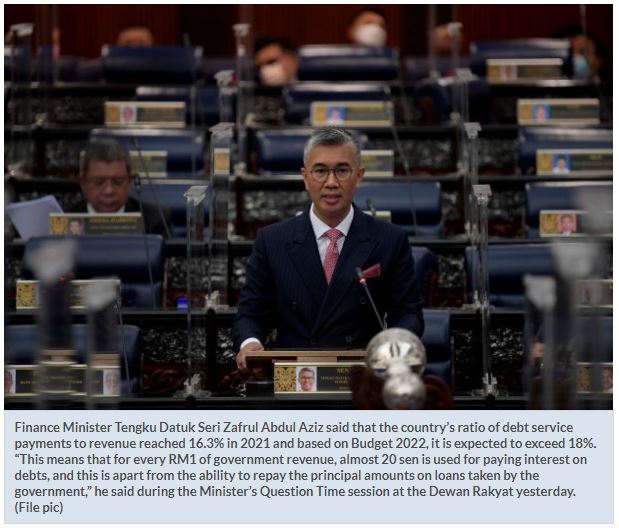Malaysia’s ability to increase debt level limited
KUALA LUMPUR: Malaysia’s ability to increase its level of indebtedness is limited, compared to developed nations, with much lower debt service ratios.
This was announced by Finance Minister Tengku Datuk Seri Zafrul Abdul Aziz, who added that the country’s ratio of debt service payments to revenue reached 16.3% in 2021 and based on Budget 2022, it is expected to exceed 18%.
“This means that for every RM1 of government revenue, almost 20 sen is used for paying interest on debts, and this is apart from the ability to repay the principal amounts on loans taken by the government,” he said during the Minister’s Question Time session at the Dewan Rakyat yesterday.
Tengku Zafrul was responding to Datuk Seri Ahmad Maslan’s (BN-Pontian) query on whether Malaysia’s debt level was still manageable and, if there was still room to borrow, why the government did not continue to borrow to assist the people.
The finance minister explained that a country’s ability to increase its borrowings does not depend solely on the ratio of debt to its gross domestic product (GDP), and the most important factors are debt capacity and debt sustainability.
He pointed out that Malaysia’s debt-to-GDP ratio is only 63% compared to developed countries like Japan and Singapore, which have a ratio of 263% and 133%, respectively.
“In addition, Malaysia’s tax-to-GDP ratio is around 11%, lower than other countries such as the Philippines (18%), Thailand (17.2%) and Singapore (13.3%),” he said.
On average, Tengku Zafrul said, the ratio of tax-to-GDP for the Organisation for Economic Co-operation and Development member countries exceeds 33%.
“This means that even if the countries’ economy recovered in the year 2022, economic growth would not generate the additional revenue necessary to cover the debt increase,” he said. — Bernama


 Thailand
Thailand




